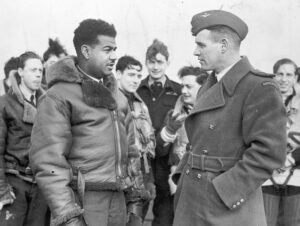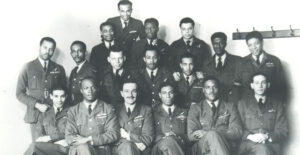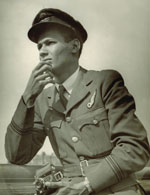Forgotten Friday – By Trish Wade – The Invisible Air Force
On Saturday 1st April 2023, a blue plaque was unveiled in Filey Town Centre to commemorate the 4,000 men who came from the Caribbean and trained on the North Yorkshire coast for the Royal Air Force at RAF Hunmanby Moor, (Previously Butlin’s Holiday Camp) during World War Two. This came about to highlight the little heard of contribution and sacrifices the Caribbean and African nations had to make to the War Effort in Europe serving in the RAF.

The image most people have of the RAF in the Second World War is of the brave, dashing young white men in blue uniforms giving their all for King and Country and that image does not usually include men and women of colour who were as equally brave and answered the call.
During WW2, the barriers that had existed to prevent men and women of colour joining the blue ranks of the RAF came down. The pre-war policy of white European races only, was changed in October 1939. There became an increasing need for more manpower, and the Air Ministry realised that by dropping the ban on coloured men and women joining the RAF could result in a greater uptake of volunteers from a wider field. By November 1940 the RAF had begun recruiting in the West Indies and Africa.

The Response to the call for volunteers was very successful. There had begun a growing concern and sense of what could happen to them in their countries if Hitler gained control. From the thousands who volunteered from the Caribbean, mainly from Jamaica, at least 450 were taken on as aircrew, over 5,000 were ground crew and there were 80 women who joined the WAAF (Women’s Auxiliary Air Force).
Despite the end of the colour bar and formal discrimination, some black people still found difficulties when it came to enlisting. Africa had a considerably less number making it through, only about 80 volunteers made it, thought in part to be due to still long held prejudice of colonial authorities. It is thought that about 5,000 volunteers were working to support RAF bases in places such as Migeria, Cambia and Sierra Leone.
In England the Air Ministry was seen to be taking the issue of racism seriously – ‘All ranks should clearly understand that there is no colour bar in the Royal Air Force.. and instant of discrimination on grounds of colour by white officers or airman or any attitude of hostility towards personnel of non-European decent should be immediately and severely checked.’ Air Ministry Confidential Order of June 1944.
Having said this, the Ministry did not always treat them as completely equal as their fellow officers, part of a report made in 1944 extolling the capabilities of black personnel selected for training went on to say ‘colour has not proved a drawback, wither to them or their relations with their fellow officers or airmen, except in one respect, they have not proved suitable as Captains of aircraft, however good the individual may be only subconscious, it will tend to lower the efficiency of the crew as a whole.’ The report inferring that they probably could not command enough respect from the rest of the crew because of their colour.
However, in most cases the fears were unfounded and a great many of the volunteers went on to prove their work and bravery in the RAF, people such as : Cy Grant (Navigator – 103 Squadron) from Guyana, to name but one of the very brave men, who was shot down and was a POW in Stalag Luft III. It was a dangerous time for coloured men to be shot down over occupied Europe, given Hitler’s attitude to all non-Aryans. He survived the war and became famous as an actor in Great Britain in the 1950’s.

Noor Inayat Khan joined as a member of the WAAF in 1940 and was recruited to the Special Operations Executive (SOE) in 1942 as a secret agent and sent to work under cover in France, where she was subsequently betrayed by a French Woman, imprisoned, tortured. She refused to reveal any information. She was executed in September 1944 in Dachau Concentration Camp. Noor was posthumously awarded the George Cross for her bravery in 1949.

Michael Manley who served with the Royal Canadian Airforce (RCAF) as a Pilot Officer went on to study at the London School of Economics, graduating in 1949, after which he returned to Jamacia and went on to serve two terms as the country’s Prime Minister.
After the end of the war, it seems that, for some, they felt the were not wanted in Britain anymore. Some stayed, many went back to their homelands, some came back again as part of the Windrush Project but fears of post-war unemployment and settling back into normal life in Great Britain, meant that they were not always made to feel as welcome as they had been during the war years and their contribution to them largely forgotten.

